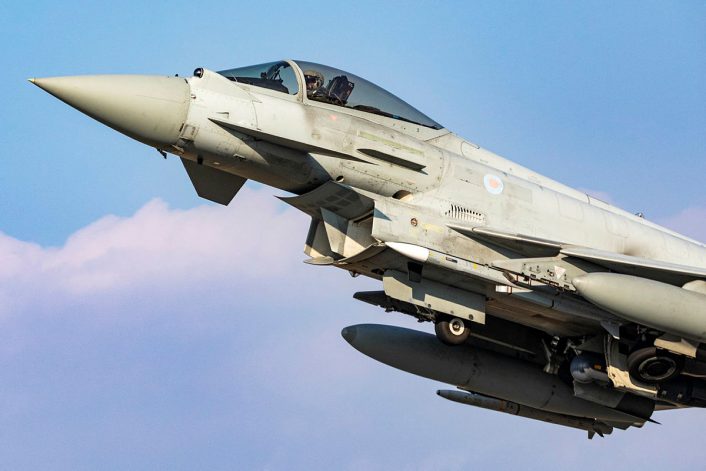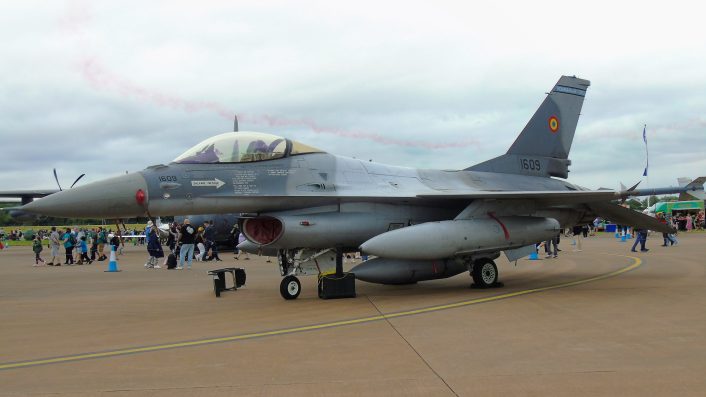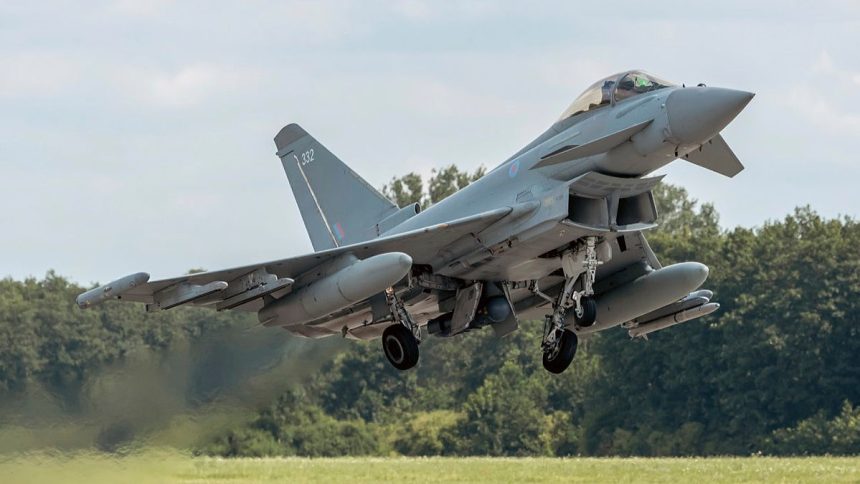The British government announced its intention to join NATO’s Operation Eastern Sentry following continued incursions of Russian drones in NATO airspace.
Royal Air Force Typhoons will deploy as a part of Operation Eastern Sentry to monitor and defend the skies of NATO’s eastern flank. These aircraft will operate directly from RAF Coningsby in the UK, utilising tanker support from RAF Voyagers to enable the long flight times to Poland and back. Here they will join a multi-national contingent of aircraft from across NATO partners to stop further Russian incursion over NATO territory.
This deployment comes a few days following the violation of Poland’s airspace on Sept. 9, 2025 by 19 Russian Gerbera drones, with a number shot down by responding NATO aircraft. A few days later, on Sept. 14, a Russian Geran-2 was detected in Romanian airspace, prompting further condemnation of Russia from NATO capitals.
Whilst the violation of NATO air space by Russian drones is not wholly uncommon, with drones often being found in fields in Estonia, Romania and Poland, this marked a significant escalation due to its scale, and the fact that NATO for the first time ever was forced to shoot down a hostile foreign entity over its territory.
Russian drone attacks the building of the National Pharmaceutical University in Kharkiv.
This is how Russian terror against the Ukrainian population looks like. Senseless killings. Destruction of education and science. pic.twitter.com/dMboiUR7In
— Денис Казанський (@den_kazansky) September 16, 2025
Questions still remain over whether this act was a deliberate escalation by Russia as it continues its invasion of Ukraine. The movement of these drones towards Rzeszów, NATO’s primary logistics hub for supplying weapons and equipment to Ukraine, indicates that this likely was a deliberate act to test NATO’s unity and its credibility to defend itself. Either way it has now prompted the UK to join the efforts to stop further violations.
French “Rafale” Multirole Fighter Jets scrambling earlier from an airbase in Poland as part of their first combat alert to defend Polish Airspace, from potential intrusion by Russian one-way attack drones, under NATO’s Eastern Sentry. pic.twitter.com/YnDOZrYy9W
— OSINTdefender (@sentdefender) September 13, 2025
So far, F-16 Fighting Falcons from Denmark, three French Rafales and four German Eurofighters have been deployed as a part of the NATO operation, joining the Italian and Dutch F-35s that are already deployed on Baltic Air Policing and Enhanced Air Policing duties. This will mark a significant build-up of NATO aircraft operating along the Eastern flank, not really seen since the start of Russia’s invasion of Ukraine.

The British deployment will be different to traditional air policing missions, in which UK and NATO aircraft are based within the state they are supporting. A detachment of Typhoons from No. II Squadron RAF only recently returned from Poland.
In fact, a few months prior, the jets have been deployed to the nation for Operation Chessman. This saw RAF and Swedish fighters join the Polish Air Force for the enhanced protection of their air space. NATO air policing missions currently take place in the Baltic states of Latvia, Lithuania and Estonia, as well as Iceland, Poland, Romania and Bulgaria.
The Typhoon is well suited for this role as it is the RAF’s primary air superiority fighter. A number of aircraft are usually assigned to the enduring Quick Reaction Alert (QRA) mission, where a number of aircraft are kept at high readiness 24 hours a day, seven days a week to respond to any threat in British skies. Whilst the F-35B Lightning II can also deploy for air policing duties and has done in the past, the significant bulk of the fleet is currently deployed to the Pacific for the UK’s Carrier Strike Group 2025, with the rest of the fleet concentrated on training.

This leaves the Typhoon, which has already proved itself during combat operations over Libya and Syria, as well as against Iranian drones flying over Iraq in early 2025 and late 2024. The Typhoon comes with a significant advantage, carrying NATO’s most advanced beyond visual ranged air-to-air missile (BVRAAM), the MBDA Meteor.
This weapon has an estimated 200 km range and top speed of Mach 4, making it highly effective against jet aircraft and cruise missiles. If these incursions were to escalate to cruise missile attacks or probing by aircraft, the RAF would be well equipped to deal with the threat.
Announcing the RAF deployment, Prime Minister Sir Keir Starmer stated that:
“Russia’s reckless behaviour is a direct threat to European security and a violation of international law, which is why the UK will support NATO’s efforts to bolster its eastern flank through Eastern Sentry.
These aircraft are not just a show of strength, they are vital in deterring aggression, securing NATO airspace, and protecting our national security and that of our allies.
We will continue to stand firm in our support for Ukraine and ramp up the pressure on Putin until there is a just and lasting peace.”
Additionally, Defence Secretary John Healey MP stated that:
“Russia’s actions are reckless, dangerous, and unprecedented. They only serve to strengthen the unity of NATO. Just as we stand with Ukraine, we will stand with our Polish NATO allies in the face of Russian aggression.
The UK is fully committed to playing its part in Eastern Sentry, increasing our military presence on NATO’s eastern flank even further.
Our advanced Typhoon fighter jets will help deter Russian aggression and, where needed, defend NATO’s airspace, making Britain secure at home and strong abroad, the foundation of our Plan for Change.”
The deployment of RAF and allied fighters will hopefully deter further incursions of such scale and, if necessary, defeat them.

Romanian Incursion
Far from the mass incursion reported in Poland, the Romanian government reported only a single drone violating their nation’s airspace. This incursion is more likely to be accidental rather than a test of NATO’s credibility, due to the fact that it was only a single drone that soon crashed in Romania’s countryside.
As mentioned before, incursions such as this have been reported all over NATO’s eastern flank and are due to the significant number of one way attack drones used against Ukraine. Individual air raids see close to one thousand drones and missiles hit Ukraine daily, and the cheap nature of these weapons mean that many go off course and lose connection to their operator during the attacks.
So far, no casualties have been reported from direct hits by Russian drones on NATO soil.

On this instance, Romanian F-16s detected a Geran-2 drone near the village of Chilia Veche and tracked it as it entered Romanian airspace from Southern Ukraine. According to the Romanian Ministry of Defence, the drone did not pose an immediate threat to people on the ground and it was soon after lost from radar, likely crashing.
Romanian F-16s are authorised to shoot down any Russian drones that enter their airspace, however it was judged that shooting the drone down would be more risky for those on the ground. Understandably this caused some consternation from the Romanian public, who did not like the idea of Russian attack drones flying overhead freely.
Today, Romania scrambled combat aircraft because of a Russian drone in its airspace. According to current data, the drone penetrated about 10 kilometers into Romanian territory and operated in NATO airspace for around 50 minutes. Also today, Poland responded militarily to the…
— Volodymyr Zelenskyy / Володимир Зеленський (@ZelenskyyUa) September 13, 2025
Ukrainian President Zelenskyy has called the latest incursion “an obvious expansion of the war by Russia” where forces of the Russian Federation deliberately test NATO’s responses with smaller incursions, allowing them to get away with more significant action later on. This tracks with Russia’s modus operandi, where the invasion of Crimea and the Donbass War preceded the full-on invasion of Ukraine, as they saw an unwillingness from NATO nations to respond forcefully to Russia’s piecemeal advances.
More will have to be done to ensure that NATO is able to match Russia’s test of their unity. So far, the deployment of RAF Typhoons is a positive step in this direction.
Czech Deployment
Czechia has also announced the deployment of a helicopter unit of three Mi-17s and 150 special forces troops to Poland, to assist in the shootdown of low level drones over Polish territory. This deployment was announced by Czech defence minister Jana Černochová who stated that “It is important that the help comes quickly and that we show Russia our unity. We are ready to send the unit within a matter of days.”

Additionally, Karel Řehka, the Czech Chief of General Staff, stated that the helicopter unit will be deployed “for up to three months,” with the precise number of personnel and aircraft changing depending on the circumstances and Polish requirements for support. This deployment echoes the use of helicopters by Ukraine and Israel to hunt low level Russian drones that could pose issues for fighters, in terms of the cost of their destruction.
Mi-8 Hip and Mi-24 Hind helicopters have used onboard guns to shoot down Shahed 136 and Geran 2 drones at low levels across Ukraine, whilst Israeli AH-64 Apaches have done the same with the onboard chain gun.
Using helicopters in this manner allows for a low-cost solution for destroying one-way drones as they do not use up expensive – and often rare – missiles for the elimination of the drone threat. This tactic is likely to be replicated further by NATO forces as the threat of one-way attack drones becomes a more significant threat against global operations.









